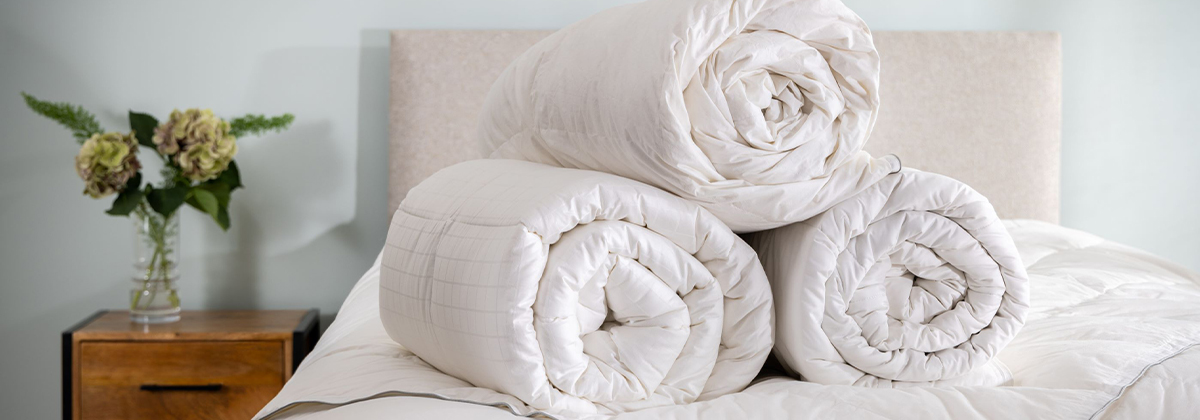22 Apr Duvet Care And Removing Stains (Part 2)
Duvet is one of the most important things to have a quality sleep, but many people don’t know much about its maintenance. Washing duvets require following some special rules that most people don’t pay attention to. In the previous section, we provided a comprehensive guide of various instructions for maintaining the quilt. In this section, we will continue with this essential information. Stay tuned in this article if you also want to learn how to clean your quilt from allergens and the principles of washing and maintaining duvets.
Common mistakes in washing duvet
To clean the duvets, you shouldn’t easily put them in the machine. If you prevent mistakes before you start cleaning, you can reduce stress, which can ruin sleep.
Reducing the overload of washing machines
All washing machines aren’t the same size and can’t handle large loads. A large duvet can completely occupy the space of the washing machine.
Wrong washing machine settings
Duvets should be washed normally. Generally, a strong wash setting is considered for dirty fabrics, such as work clothes. The normal setting isn’t effective in preventing excessive wrinkling.
Over drying
Since duvets take up much, they may take a while to dry.
Removing the duvet stain
Staining of the duvets is one of the daily unpleasant occurrences. Oil, ink, blood, cosmetics, and sweat stains are among the most important problems of dirt and staining of duvets. There are a lot of ways to remove stains. You must read this article if you are used to eating, drinking, writing, and working in bed. If you also face the problem of removing duvets stains, don’t miss reading this article.
Fat stains
To remove grease stains from duvets easily, it’s better to remove them as soon as possible. Fat stains are harder to remove if they stay on the fabric longer. To remove grease stains from duvets, you need a white towel, a toothbrush and a small amount of dishwashing liquid and baking soda.
First, place the towel on a flat surface and then place the part of the fabric with the grease stain on the towel. If the stain is new, put some baking soda on it. But if it’s old, it’s better to pour a few drops of dishwashing liquid on it and after 15 minutes, spread the material evenly with a toothbrush and repeat this step several times. Brush gently so as not to damage the texture of the fabric. After you repeat this process several times, the fat spots will disappear slowly. In the last step, wash the duvets with lukewarm water and dry them in the sun. Your quilts are ready to use on the first day without greasy stains.
Blood stains
There are many ways to remove blood stains from bedding. If you remove the duvet immediately after it becomes bloody, no traces of it will remain; But if the blood stains are old, removing them from the fabric becomes very difficult. One of the practical methods that remove blood stains is to use vinegar. Immediately after the duvet gets dirty, put some vinegar on the stain, and after 15 minutes, wipe the vinegar with a soft cloth or clean towel and wash it. The blood stain is completely removed.
Another effective and simple way to remove blood stains from a duvet is to wipe the stain with cold water. In this method, it’s enough to wash the part of the dirty duvet with cold water and place it in front of the sun. No more traces of blood stains on your fabric. This method is very useful for fresh blood stains and won’t be effective for removing old stains.
Ink stains
If you have a child or teenager who does all his homework on the bed, you have undoubtedly faced the problem of ink stains on the duvet. Most people believe that ink stains on duvets can only be removed with the help of dry cleaning and advanced chemicals. You can also remove the stain using baking soda and a toothbrush that you first learned about in this situation.
Using white alcohol to remove ink stains is another method. With the help of a clean cloth or a few pieces of cotton dipped in white alcohol, slowly remove the ink stains. After 10 minutes, no traces of ink remain on the duvet. Using a mixture of glycerin and detergent to wash the fabric is another home method of removing ink stains.
Makeup stains
Staining a duvet with cosmetics is a common problem among all women. Lipstick, mascara, powder cream and nail polish are all removed from fabric differently.
Lipstick stains
To remove all makeup stains, the most important thing is your speed in doing this. Don’t let stains get old. You can use toothpaste or soap to remove lipstick stains from duvets. Apply the toothpaste on the stains and repeat this process for 10 to 15 minutes with the help of a toothbrush. Then wash the area with a clean cloth and remove the stain easily. You can also wash the stained part with soap and remove the stains.
Mascara stains
To remove the marks and stains of mascara, you must use the oily solvent available in dry cleaners. This solvent destroys the adhesion of the protein in the mascara. Gently brush on the stains with a toothbrush and wash the area with soap and water after 10 minutes.
Powder cream stain
Spilling powder cream and staining the duvet is one of the most common cosmetic stains. The air and steam flow in it quickly destroys the spots of powder cream. Just apply hot heat to the stains using a hair dryer.
Nail polish marks
The easiest and most practical way to remove nail polish stains from a duvet is to use acetone. Place a tissue soaked in acetone on the stain and press. Repeat this until the nail polish stains are completely removed. These stains are easily removed from the fabric. Note that your fabric is durable, and acetone doesn’t tear them.
Sweat stains
The stain and smell of sweat on the duvet will completely change the room’s atmosphere. Under no circumstances should the bedclothes, bedding, duvet and room space be dirty or have an unpleasant smell. You can use vinegar, baking soda, or a mixture of lemon and baking soda to remove sweat stains. Pour one glass of vinegar into a spray and apply it completely on the stains. After 15 minutes, wash the area with soap and water. To use baking soda or its mixture with lemon, it’s also necessary to rub the mixture of baking soda with hydrogen peroxide or lemon on the stain for about 15 minutes and then wash that area. The sweat stain will disappear completely.
To wrap up
Now that you know the important points in washing duvets, It’s time to get down to business. By following these tips, you can easily care for your duvets. When you use your duvets again, you will feel better. If your quilt doesn’t have sheets, you must wash it once a year. But if it has sheets, you can wash it once every three years. Of course, it’s even better if you can do it every year. If you don’t have the opportunity or patience to wash your clothes, you can count on the specialized NeatEx team. NeatEx washes your clothes best and ensures you have clean and tidy clothes. Don’t damage your valuable clothes with improper washing. With the most advanced tools and the latest knowledge, we will deliver your clothes of the best quality as soon as possible.




Sorry, the comment form is closed at this time.